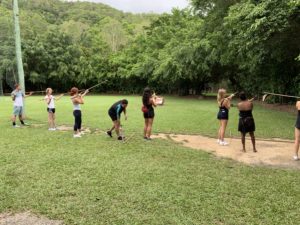During our visit to the Australian Centre for the Moving Image (ACMI) in Melbourne, we were able to learn about the history of film through various readings and even older flip film technologies. From the moment I entered into ACMI’s main gallery, I felt a little overwhelmed by the amount of screens and information they had provided but after taking time to walk through the museum was very well laid out. The museum started from the beginning of Australian film with moving pictures. At first, they had used technology to rapidly show still images making them into the first moving image films. From this point, film seemed to take off as television came to be the next big invention bringing moving image pictures to homes around the country. Around the world, television was beginning to be revolutionized in the 1930s as Russia, Japan, and Germany began to host regular television broadcasts although they offered extremely low picture quality still. Still, the ability to broadcast both voice and video across countries was a major step for television. Finally, in September 1956, Bruce Gyngell was the first to appear on television to say the words, “Good evening and welcome to television”. The introduction of the television was key in this time and needed in Melbourne and Sydney for the 1956 Olympics which was to be televised. The next major event to be televised was in 1977 for the World Series of Cricket. Kerry Packer owned Australia’s Nine Network and he made a bid for exclusive rights to broadcast cricket nationwide but was turned down because of favor towards the national broadcaster ABC. Instead, Packer broke off and created the World Series of Cricket which would pay higher salaries in order to attract star players. Packer ended up revolutionizing the game and eventually the Cricket Board decided to work with him after all. Along with all this great information about the history of Australian TV and film, there was also a gallery dedicated to the growth of video games over the years internationally. The museum provided interactive ways to learn about these games and gaming systems which have all impacted what we have today. ACMI had interactive games from the original gaming system, the Atari, and allowed you to play through the progression through the original Mario Bros. era and to Minecraft, a 2009 game which revolutionized gaming. Finally, the gallery ended with a virtual reality (VR) experience where the user was dropped into a city and given superpowers to destroy the infected buildings in sight. This entire experience was great to see as ACMI did a good job with the progression through the image timeline and how it has lead to what we see today in modern TV, video games, and film.




